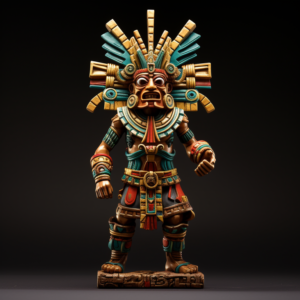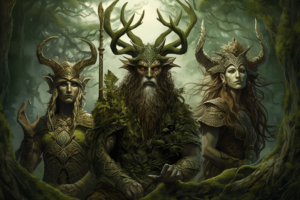Brigid is a revered goddess in Celtic mythology, known for her association with fire, poetry, healing, and fertility. Her origins can be traced back to ancient Celtic beliefs, where she emerged as a multifaceted deity embodying the creative and nurturing forces of the natural world.
Appearance
Brigid is often depicted as a radiant and graceful figure, emanating warmth and light. She is portrayed with flowing golden hair, reflecting her connection to the sun. Brigid’s gentle countenance and compassionate demeanor symbolize her role as a nurturing and protective goddess.
Family
In Celtic mythology, Brigid is often associated with familial relationships and divine lineages. She is sometimes depicted as the daughter of the Dagda, the chief god of the Tuatha Dé Danann, and is also referred to as the sister of the gods Aengus and Miach.
Symbols
Symbols associated with Brigid encompass fire, the sun, and the sacred flame. Brigid’s crosses, woven from straw or rushes, are commonly recognized as symbols of protection and are hung in homes to ward off evil. Other symbols may include the anvil, representing craftsmanship and blacksmithing, and the cauldron, symbolizing healing and nourishment.
Powers & Duties
As a goddess associated with fire and inspiration, Brigid possesses powerful abilities and talents. She is believed to have control over the transformative and purifying properties of fire, bringing illumination, warmth, and purification. Brigid’s powers extend to healing, divination, poetry, and craftsmanship, representing the creative and artistic aspects of life.
Worship
Brigid’s prominence in Celtic culture is evident through the widespread worship and rituals dedicated to her. Imbolc, a festival held on February 1st, marks the beginning of spring and is associated with Brigid. Devotees engage in rituals such as lighting fires, weaving Brigid’s crosses, and leaving offerings to honor her, seeking her blessings for fertility, creativity, and protection.
Facts About Brigid
- Brigid’s importance extends beyond Celtic mythology, as she was also revered in the Christian era as Saint Brigid of Ireland, blending pagan and Christian traditions.
- Brigid’s festival, Imbolc, celebrates the awakening of the Earth from winter’s slumber and marks the return of light and fertility.
- Brigid’s influence as a patroness of poets and bards made her a source of inspiration and creativity, encouraging the pursuit of artistic expression.
- Brigid’s role as a protector and guardian is emphasized through the belief in her ability to ward off illness, evil spirits, and misfortune, bringing blessings and good fortune to her devotees.
- Three rivers are named for Her – Brigit, Braint and Brent in Ireland, Wales and England, respectively.
- Irish mythology mentions three goddesses of the same name: Brigid the wise or Brigid the poet, Brigid the healer, and Brigid the smith. Thus, Brigid may have been a triple deity, one goddess worshiped in three different forms.
*As an Amazon Associate I earn from qualifying purchases.






